|
A late-summer heatwave impacted large parts of Europe with well-above-average temperatures for an extended period in the last days of August 2024. The unseasonable warmth lasted well into early September 2024. Especially at higher elevations in the Alps, the month of August brought record-breaking temperatures.
After a potent trough had passed over Europe in the period from August 25 to August 27, 2024, a strong ridge pattern could establish itself over Europe. The ridge extended from the Iberian Peninsula well into Western Russia. Over Europe, unseasonably warm air masses were advected across the continent. For extended periods, the 850 hPa temperature deviations reached more than +10 K. The advection of these very warm air masses was exacerbated by a broad cut-off low residing over Southeastern Europe. The period of unseasonably warmth/heat ended on September 08, 2024, when a large trough over the Eastern Atlantic moved into Europe bringing well-below-average temperatures.
|
Mean 500 hPa geopotential (left) and 500 hPa geopotential anomaly (right) over Europe in the period from 28.08.2024 - 08.09.2024, source:
PSL NOAA
|
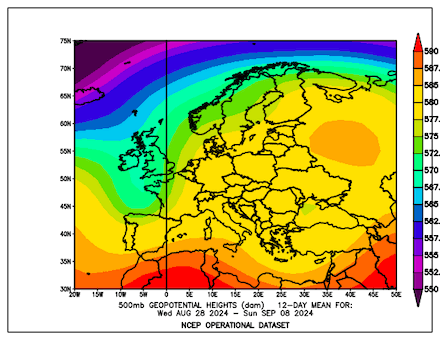 |
 |
In the mean 500 hPa geopotential for the period from August 28 to September 08, 2024, a brought ridge over Europe is visible. The 500 hPa geopotential anomaly for the same period shows strong positive geopotential deviations across large parts of Europe. Only over the Iberian Peninsula had below-average geopotential for said period had been overserved. The highest geopotential deviations can be found in Scandinavia and Western Russia. Due to the omega-like structure of the ridge, high geopotential values pushed far northwards into Scandinavia and Western Russia.
|
500 hPa geopotential, 1000 hPa to 500 hPa thickness, and sea-surface pressure over Europe, 28.08.2024 00 UTC - 08.09.2024 00 UTC, source:
wetter3.de
|
 |
 |
 |
 |
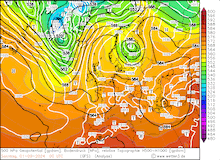 |
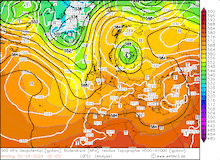 |
 |
 |
 |
 |
 |
 |
In detail, it becomes apparent, that during the period from August 28 to September 08, 2024, multiple troughs moved from the Eastern Atlantic across the British Isles and turned sharply northwestwards into the Arctic. Ahead of each trough, the advection of very warm air masses from the Mediterranean was exacerbated. Analyzing the daily geopotential development over Europe, multiple periods of these troughs passing by Continental Europe can be identified. The first period occurred between August 28 and August 30, 2024. By September 02, 2024, the same trough formed a complex cut-off structure over Scandinavia with the ridge expanding around the cut-off well across the Arctic Ocean. In Central Europe, this complex ridge pattern led to a second temperature peak. A third temperature peak was observed when a strong trough moved across the British Isles. Both on September 04 and September 05, 2024, extreme temperatures for September were observed in Central Europe. A fourth and final temperature peak was observed when the now cut-off low was re-integrated into the main westerly flow in the period from September 07 to September 08, 2024.
|
850 hPa temperature over Europe, 28.08.2024 00 UTC - 08.09.2024 00 UTC, source:
wetter3.de
|
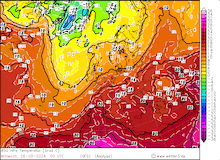 |
 |
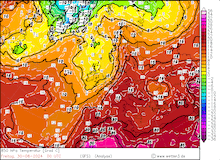 |
 |
 |
 |
 |
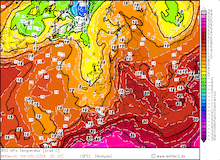 |
 |
 |
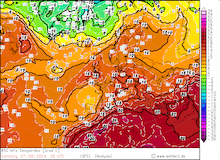 |
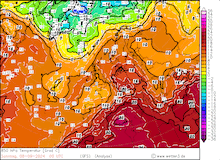 |
Comparing the daily development of the 500 hPa geopotential to the daily development of the 850 hPa temperature across Europe, one can identify the previously mentioned periods of extreme warmth. Throughout the period from August 28 to September 08, 2024, the 850 hPa remained above 15 °C in Central Europe. Peaks of more than 20 °C were observed. In late August and early September, the mean 850 hPa temperature over Central Europe is about 10 °C. By the end of the first decade of September, the mean decreases to below 10 °C. Especially over Eastern Germany, the 850 hPa temperature remained more than 5 K above the average in this period. In contrast, over Northwestern Germany and the Benelux states, cold air masses from the passing troughs over the North Sea could penetrate the area and lead to intermittent temperature drops to seasonal values.
|
Daily 2 m maximum temperature over Germany, 28.08.2024 - 08.09.2024, source:
wetterzentrale.de
|
 |
 |
 |
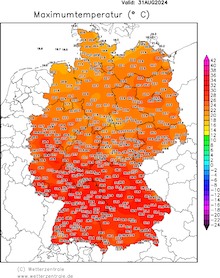 |
 |
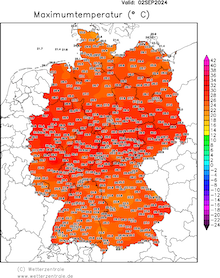 |
 |
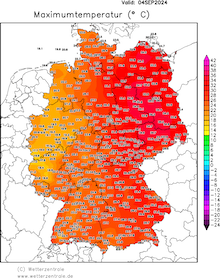 |
 |
 |
 |
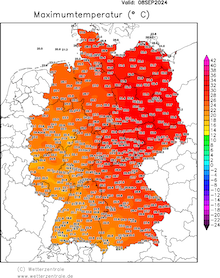 |
In the period from August 28 to September 08, 2024, a measuring site in Germany recorded every day a maximum temperature above the 30 °C mark. The highest temperature of this heatwave was observed on August 29, 2024, in Cottbus, BB with a maximum temperature of 35.5 °C. This temperature is close to the climatological maximum for the end of August. However, more extreme relative to the climatological mean were the temperatures between September 03 and September 05, 2024. In this period, intense heat impacted mainly Eastern Germany. Many stations recorded 6 straight days of more than 30 °C. Both on September 04 and September 05, 2024, dozens of new monthly temperature records were measured in the central and eastern parts of Germany. The highest temperature on these two days was recorded in Doberlug-Kirchhain, BB with a maximum temperature of 35.2 °C on September 04, 2024.
September 04, 2024, was a characteristic day for the second part of this heatwave due to the very distinct temperature gradient over Germany. While Eastern Germany recorded scorching hot temperatures, the maximum temperatures in the northwestern part of Germany remained around the 20 °C mark. The all-time temperature record for the highest temperature measured in September in Germany remained untouched. To this day, no measuring site in Germany has recorded a temperature higher than 36.5 °C in September. However, this 113-year-old record observed in Jena remains. Further southeast in Austria, temperatures along the Danube Plain reached more than 35 °C for multiple days in late August and early September. The highest temperature of 35.7 °C was observed on August 30, 2024, in Langenlebarn near Vienna.
While large parts of Central Europe saw only very scarce precipitation, the troughs over the British Isles occasionally led to the formation of thunderstorms. Some of which were severe. Due to very weak upper-level winds, these thunderstorms could often bring abundant precipitation to very small areas in a short period. Notably, a thunderstorm over the Eifel Mountains brought 78.3 mm of rain on September 02, 2024, to the measuring site a Prüm-Walzerath. This is the highest daily precipitation in August observed at the measuring site since recording began in July of 1892. On September 04, 2024, a mesoscale convective system moved over Northern Germany. At the measuring site in Bremerhaven, a new all-time daily precipitation record was observed with a daily precipitation total of 76.2 mm. Observations here began in January of 1949.
On September 05, 2024, another mesoscale convective system moved over Baden-Württemberg. Daily precipitation totals of up to 87.6 mm were observed. The heatwave across Germany ended with a strong cold front moving across Germany on September 08, 2024. Especially over the central part of Germany, this cold front brought heavy rains. In the area between the Thuringian Forest and the Harz Mountain range, widespread precipitation totals of more than 50 mm were observed. While these heavy rains brought local flash flooding, they assisted in extinguishing a large forest fire in the Harz Mountain range.
With a monthly mean temperature of 19.85 °C, August 2024 was one of the warmest August months on record in Germany. While temperature deviations at lower elevations were substantial, in the Alps, many monthly temperature records were broken. At the top of the Zugspitze Mountain in Bavaria, the warmest month on record was observed. The mean temperature of August 2024 was 7.27 °C. This is 0.6 K higher than the previous monthly record measured both in August 2003 and July 2006. Furthermore, in the period from July 04 to September 09, 2024, no frost was observed at the nearly 3000 m high measuring site. This is also the longest frost-free period observed at the top of the Zugspitze Mountain.
In Austria, the summer of 2024 was the warmest on record. Notably, Vienna saw 44 tropical nights where the temperature did not drop below 20 °C. Moreover, Vienna saw also 45 days where the maximum topped over the 30 °C mark.
Text: KG
September 15, 2024
|




